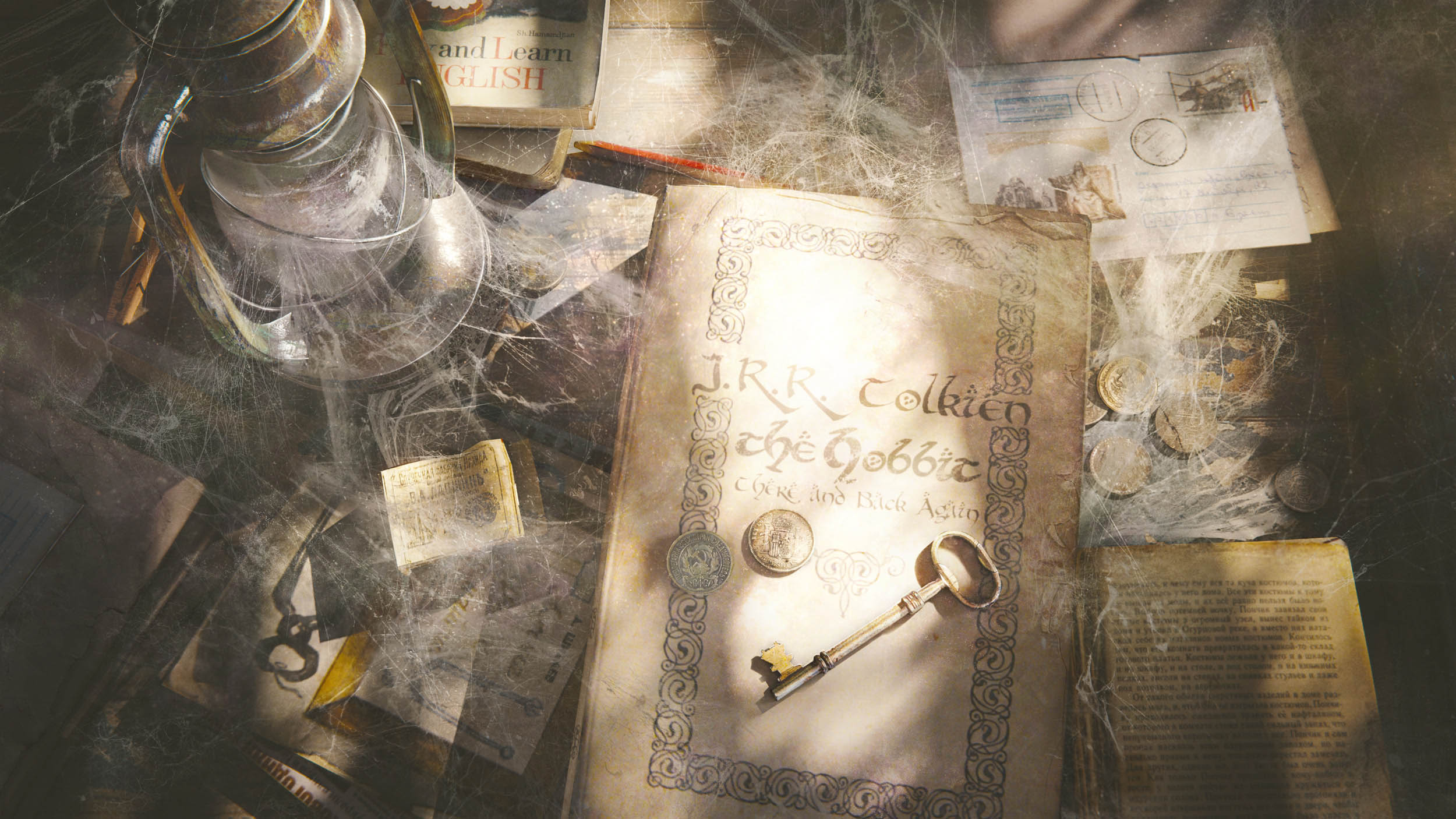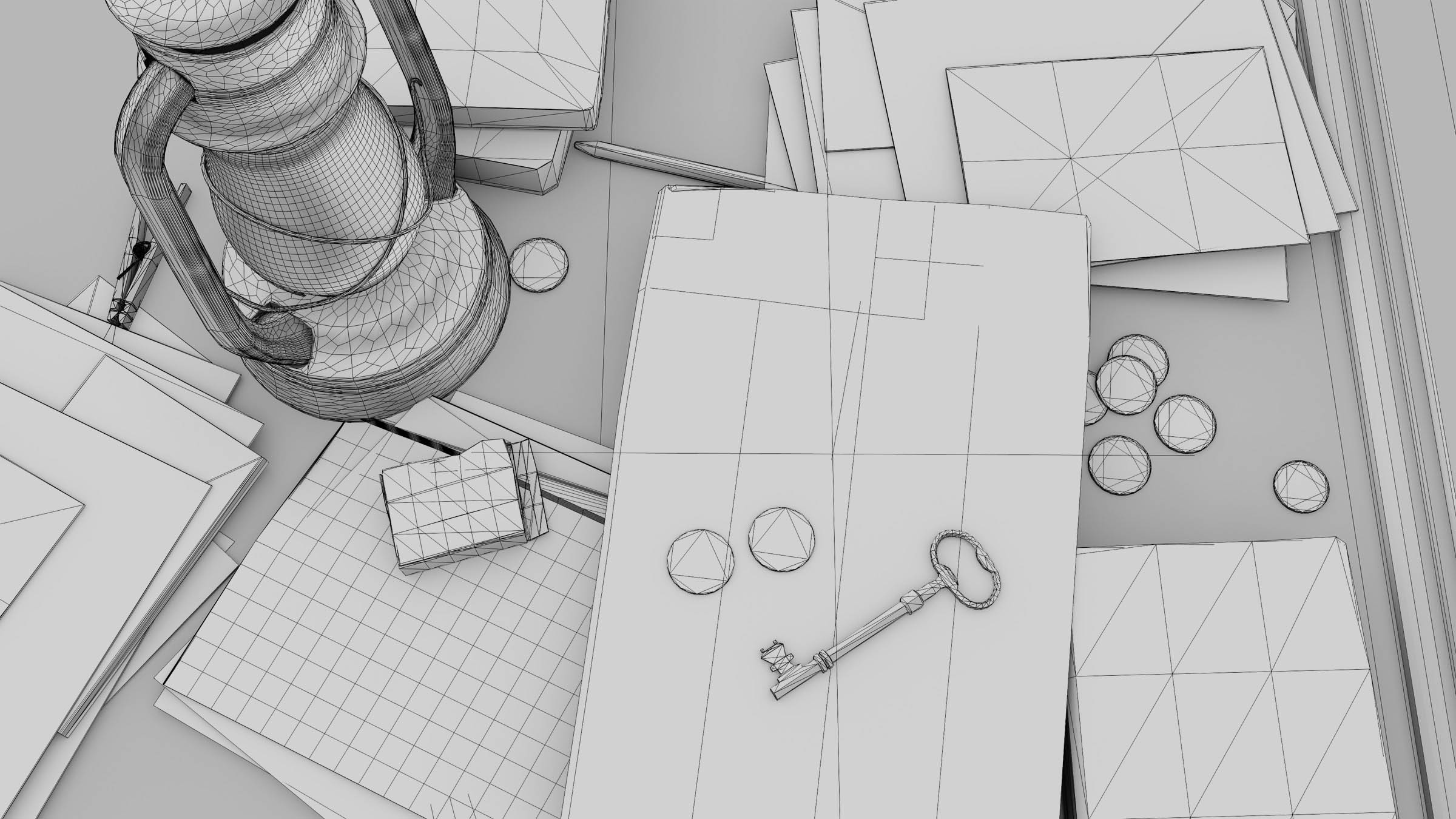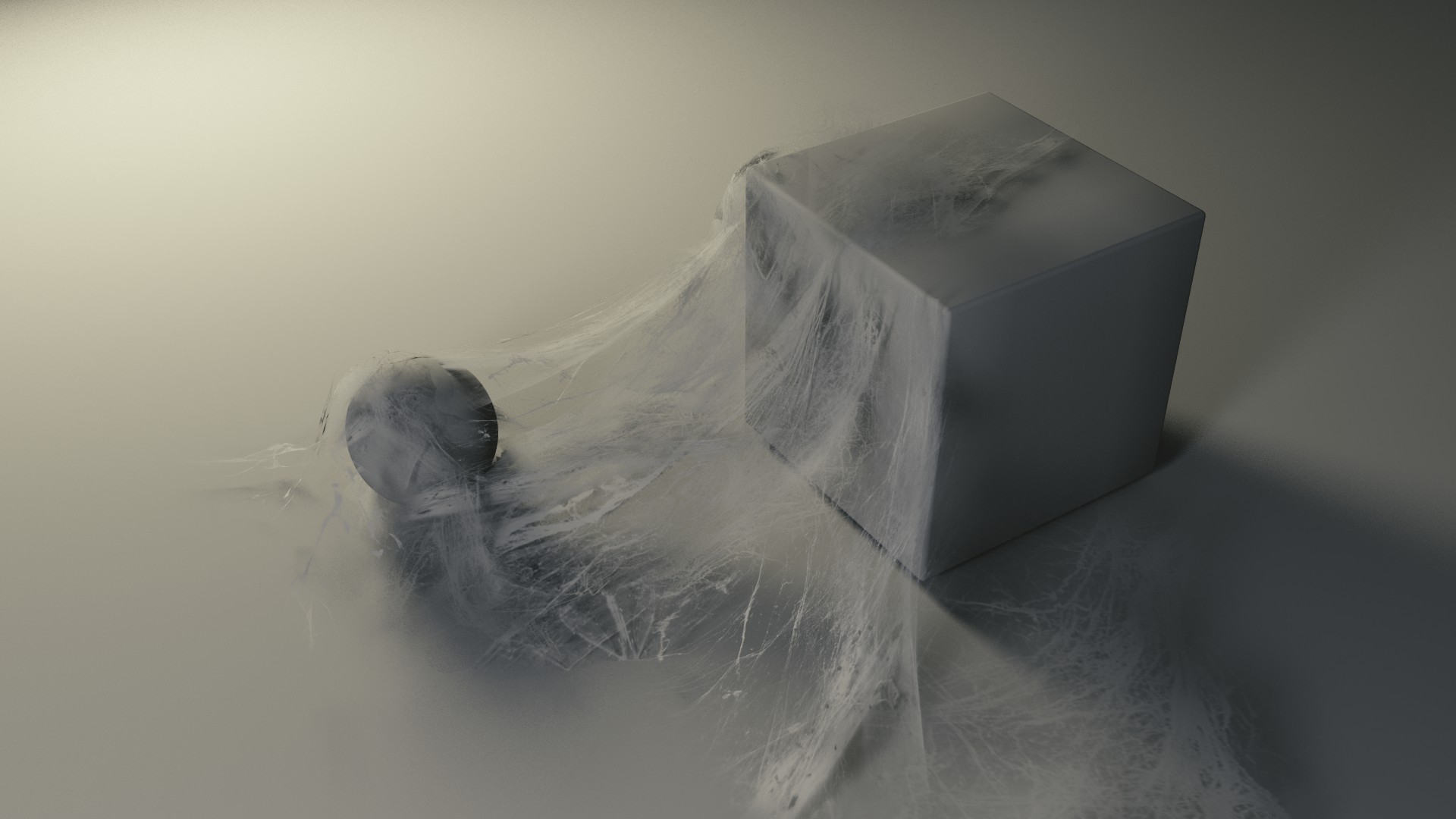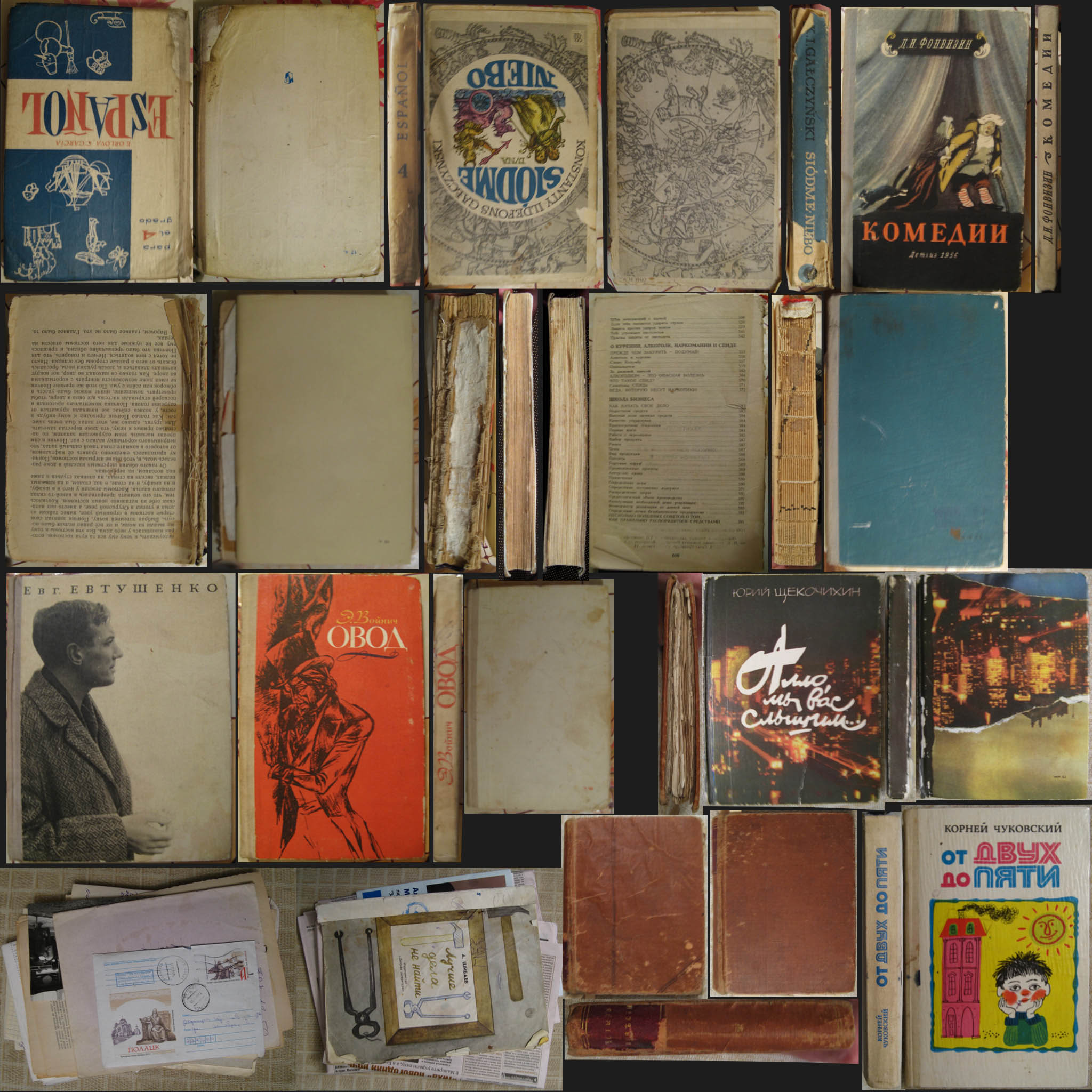Dedicated to J.R.R. Tolkien’s world, that is still lurking somewhere around that corner.


About the image
Imaginary attic, with the book hidden somewhere in its depths, was pretty damn visually provoking (at least, when I imagined it).
Came almost as 1 piece, and that was great as I didn’t have to painfully iterate through various details and stuff. Everything was just there.
Dappled Light
The biggest discovery for me in this ‘The Hobbit: There and Back Again’ scene was the dappled light – as James Gurney is calling this kind of light texture. As I desperately want to share my 5 cents about such lighting, I’ve already started writing a tutorial.
Indeed, the right lighting can transform dull image into pretty nice image, rich on atmosphere and goosebumps.
If you want to know how to set up this kind of light and shadow interplay in Blender, check Light Texture tutorial.

Alpha-mapped Spider Webs
This semi-transparent woven bastards proved to be not so easy to render. First I tried geometry way of doing webs – and quickly arrived at alpha-mapped solution. Call it game engine way, nothing more than plane, transparent shader and texture plugged in. The trick is to bend the basic plane with a texture, so it looks 3d.

Photo Textures of the Old Books
Some years ago, I made a few photos of the old dusty books and papers (as you can imagine, they were lying somewhere in the attic). Low res, but so damn useful sometimes. Feel free to download it and use in your grungy scenes.




Jaime Pérez
i love it! I’d like to know how the spiderweb was made 🙂
Gleb Alexandrov
Actually, while I was doing spider webs, I saw how interesting that technique could be. So, that won’t be overkill to do a tutorial about webs.
Ethan Hansen
Fantastic!! To me, the lighting is the crucial part and what makes this image really pop. I’m also a huge Tolkien fan. (Read the Silmarillion 8 times, Narn i Chîn Húrin 6 times, LoTR 10-12, Hobbit 20+).
Gleb Alexandrov
Awesome!
Gremllin
Hi Gleb can you please share an a quick overview of the material of the spider web???? 🙂
rickles13
The spider webs are awesome would love to know how that is done. Also I am fascinated with the lighting. Great job Gleb
Gleb Alexandrov
Rickles, lighting is what makes this image, agree. In some sense, it even can be called the subject of the scene.
rickles13
The lighting is what I find hardest to grasp. But at least with blender it is a little more intuitive then some other 3d programs
Gleb Alexandrov
Yeah. Having a realtime viewport rendering helps a lot in setting up lighting.
I’m in the middle of writing series of tutorials about lighting, so hopefully it will shed light on that subject a bit 🙂
Glen Johnston
AHHHHHHHHHHH…Shed light.
simenesky
Spider wed, spider web, spider web !!!
Gleb Alexandrov
Exactly like that.
eknightGER
hi Gleb, nice image, long time this desk was not looked after ;-). Did you throw the spider webs over the scene with a cloth simulation? That was my first idea after you mentioned alpha maps. Also physically geometry would not be right, spider webs are so thin, that they can only be seen because of the light that is broken in the molecules of the strings.
i certainly look forward to the lighting part, that is looking great.
The only thing that took me is that the image still looks a bit HDRI, probably because the Hobbit is in my mind as cinema style. Would adding some film grain change the appearance? Happy Christmas time!
Gleb Alexandrov
Thanks, nice observation about geometry! That’s right, simulated cobwebs should be so super-high definition to look even close to real webs. Moreover, we don’t have such plugin for Blender (though about Ivy a second ago but not).
Though, I remember similar script for 3ds max called ‘cobwebs’. http://jokermartini.com/cobwebs/
Regarding cloth – I think that would be cool way to create the base. But I’ve just placed some 4 poly planes with subsurf modifier and bent it by hand.
p.s. Already added some grain to breathe the life into image, but maybe it would be even better if I added some more.
Hamza CHEGGOUR
Hi Gleb, very nice render, my only observation is about the image contrast ans color balance, this is quick retouch I did if you don’t mind
Gleb Alexandrov
Hamza, I like your variant too! 🙂 More fantasy-looking and better in terms of contrast. Thanks for posting it.
Hamza CHEGGOUR
you’re welcome Gleb,
and your render is great it just lacks some contrast; generally speaking check out the histogram for fine adjustments
http://digital-photography-school.com/how-to-read-and-use-histograms/
Souvik Karmakar
Gleb did you not render it in high res???
Gleb Alexandrov
Actually, I did. Try right clicking on the image, then click ‘Open in the New Tab’, or something like that.
Souvik Karmakar
oh! my bad. It was fine 😀
Reynante M. Martinez
Another fantastic piece from you, Gleb. To be honest, the spider webs are a huge visual addition to this. Very well done! This makes me want to read the books. 😉
– Reyn
Joe Grimer
The English book at the top made me laugh 🙂
Gleb Alexandrov
😉
Pingback: Blender Tutorial: Light Texture or How to Breathe Life into a Dull Scene
Java
This makes me want to go hide in a hole in the woods and cry. This is AMAZING.
Gleb Alexandrov
Thanks, Java.
simenesky
Can you tell us how did you make spider web ? Tnx in advance !
Gleb Alexandrov
Yes. I’ll make a tutorial, pretty soon, I hope.
Oliver
Is there any chance you could share the spiderweb textures / tell us where they came from? I love the look and I had an idea for a scene of a similar style a while back that could really benefit from this awesome idea.
Giuliano D'Angelo
Your thoughts and tips were very useful for my latest work, “coffee hardwork”.
http://www.giudansky.com/illustration/56-coffee-hardwork
Gleb Alexandrov
Giuliano, really glad to hear it! And I can almost smell coffee, by the way.
Giuliano D'Angelo
Better smelling the coffee then feeling the iron cast!
Glad Glab! 🙂 And thanks again. The best of your tips is light texture projecting, it’s something I love, it’s so scenographic. And you can paint with light, it remembers me the long exposures with camera.
Tylor Huebner
Can I ask why you ran the topology this way? I first checked to see if it was all square and they are but was this just a way to ad more detail? Just curious, great render!
Gleb Alexandrov
Tylor, as far as I remember this topology is caused by subsurf, used on triangulated geometry. (and it was triangulated because initially it was used in a game engine 🙂
Tylor Huebner
Thanks for your quick response. That makes a lot of sense. I just came from watching the podcast you did with Andrew Price on the Guru channel and wanted to check out more of your work. Thanks again!
Michel Rochette
Alpha-mapped Spider Webs!
Joseph Charles
Thanks I never realised the power of the transparency shader